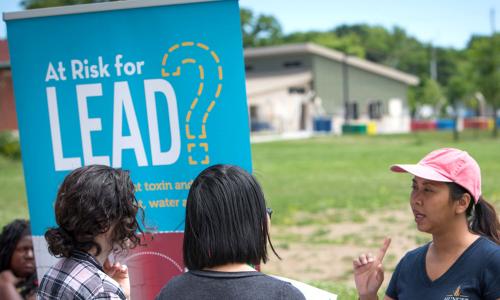In an attempt to reduce litigation costs, Georgia-Pacific launched a secret campaign to produce and publish counterfeit science designed to raise doubts about the dangers of asbestos.
What Happened
From the turn of the century through the 1970s, asbestos was inescapable. The so-called “magic mineral” was in fireproof theater curtains, gas masks, prison-cell padding, brake linings, and thousands of other products.
One such product—a version of the construction material known as joint compound, sold under the name Ready-Mix—contained asbestos from 1965 to 1977 and proved to be a major problem for its manufacturer Georgia-Pacific, a conglomerate now owned by Koch Industries that specializes in wood and paper products. As the dangers from asbestos became publicly known, Georgia-Pacific, like many other companies that had made asbestos-containing products, became swamped with a deluge of legal claims from people who had contracted lung disease from exposure to the company’s product.
Rather than face those claims honestly, beginning in 2005, Georgia-Pacific crafted and published counterfeit science—seeding the literature with articles intended to raise doubts about the dangers posed by asbestos. In so doing, the company created a life-threatening hazard by deceiving those who rely on science to understand the health risks of asbestos exposure.
Asbestos—which is not a single mineral at all, but rather a collective name for six fibrous minerals—has been shown by many scientific studies to be extremely dangerous to human health. Both domestic and international government agencies now classify it as a known human carcinogen, linked to asbestosis, mesothelioma, and other lung cancers. Since the 1970s, its use has been heavily regulated, although it is not banned in the US.
In 1977, as the Consumer Product Safety Commission (CPSC) moved to ban asbestos-containing joint compound, Georgia-Pacific’s chairman even wrote to CPSC that “We support a total ban on spackling compound containing asbestos,” as Georgia-Pacific had already “ceased using asbestos in our product and switched to a substitute.” Despite that public statement, however, the company privately worried about its liability for having sold the asbestos-containing product for many years.
By 2002, concern about asbestos-related legal claims had severely damaged Georgia-Pacific’s stock. An unflattering three-part series in the Atlanta Journal-Constitution that year revealed that Georgia-Pacific was aware of the science showing the dangers of asbestos for several years before the company put a warning label on Ready-Mix. The newspaper series caused Georgia-Pacific’s chairman to pen an op-ed in the same paper, claiming that “throughout the years we’ve dealt with the legal consequences of asbestos fibers, we have worked diligently and in good faith to resolve a staggering 250,000 individual legal claims,” and that “we have consistently acted responsibly—for victims, our employees and shareholders.”
Even if the company did act as it claimed up to 2002, by 2005—under the guidance of the same chairman—Georgia-Pacific had turned to counterfeit science to fend off lawsuits. That year, the company created a so-called research program—run through its legal department—that knowingly produced flawed science and published it in independent scientific journals while failing to adequately disclose the authors’ conflicts of interest.
Documents later obtained by the Center for Public Integrity revealed that Georgia-Pacific put its research strategy into action by hiring its head of toxicology, Stewart Holm, for a “separate and distinct” role as a so-called “litigation consultant.” Routing Holm’s new work through the legal department allowed the company to claim attorney-client privilege over all documents related to his counterfeit science work, thereby keeping it from the public—a tactic pioneered by the tobacco industry when it conducted counterfeit research to confuse the public about the dangers of cigarettes.
With the counterfeit science program tucked away in its legal department, Georgia-Pacific published 13 scientific articles that were deeply flawed, both in methodology—for instance, opting for a five-day study rather than the preferred two-year study to test whether chronic inhalation of fibers can cause cancers, fibrosis, or mesothelioma—and by not adequately revealing the authors’ clear conflicts of interest. None of the papers published through this scheme, for example, disclosed that Georgia-Pacific’s legal team had been overseeing almost every aspect of the research.
A multi-year legal battle over internal documents about Georgia-Pacific’s research program culminated in a unanimous ruling against the company in June 2013. A New York state appeals court affirmed a trial court’s ruling that the company must turn over the documents so that the court could determine whether Georgia-Pacific’s actions over the research program were in furtherance of fraud and therefore not covered by attorney-client privilege. The court found ample evidence that Georgia-Pacific’s actions could have been in furtherance of fraud, including the company’s failure to disclose that its in-house lawyer had reviewed the manuscripts before submission, or that Holm had been concurrently employed with the company for asbestos litigation purposes.
Why It Matters
As this case shows, intentionally publishing counterfeit science endangers public health. People rely on scientific literature to understand the hazards they face at work, at home, and anywhere else. When companies create and publish knowingly flawed science, or even when they fail to disclose important (and in most cases, required) conflicts of interest to journals, the public pays the price. Sometimes, as in this case, matters of life and death are at stake.
Asbestos is especially notable because of how dangerous it is to human health. As noted by the Occupational Health and Safety Administration, “Breathing asbestos fibers can cause a buildup of scar-like tissue in the lungs called asbestosis and result in loss of lung function that often progresses to disability and death. Asbestos also causes cancer of the lung and other diseases such as mesothelioma of the pleura which is a fatal malignant tumor of the membrane lining the cavity of the lung or stomach.” Thousands of Americans die every year because of asbestos exposure.
Counterfeit science about asbestos is also particularly damaging because it took many years for the public to fully recognize the dangers of asbestos that scientists were uncovering. Documents released in lawsuits in the 1970s show that major manufacturers knew about the dangers of asbestos as early as the 1930s, but ignored, buried, or silenced scientists and science that could have publicly brought forth the information to the public. Indeed, it took until 1964 for research about the dangers of asbestos to make waves publicly, forcing companies to change their ways and the government to regulate asbestos. And the author of that pioneering science published in 1964—Dr. Irving Selikoff—faced scrutiny and harassment from the asbestos industry.
The question remains: how much safer would the public be if industry had listened to the science in the first place, and if unscrupulous companies such as Georgia-Pacific had not devoted years and resources to undermining the scientific understanding of asbestos with counterfeit science?




